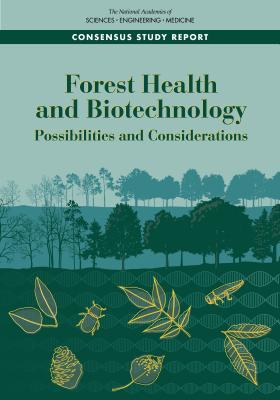The American chestnut, whitebark pine, and several species of ash in the eastern United States are just a few of the North American tree species that have been functionally lost or are in jeopardy of being lost due to outbreaks of pathogens and insect pests. New pressures in this century are putting even more trees at risk. Expanded human mobility and global trade are providing pathways for the introduction of nonnative pests for which native tree species may lack resistance. At the same time, climate change is extending the geographic range of both native and nonnative pest species. Biotechnology has the potential to help mitigate threats to North American forests from insects and pathogens through the introduction of pest-resistant traits to forest trees. However, challenges remain: the genetic mechanisms that underlie trees' resistance to pests are poorly understood; the complexity of tree genomes makes incorporating genetic changes a slow and difficult task; and there is a lack of information on the effects of releasing new genotypes into the environment. Forest Health and Biotechnology examines the potential use of biotechnology for mitigating threats to forest tree health and identifies the ecological, economic, and social implications of deploying biotechnology in forests. This report also develops a research agenda to address knowledge gaps about the application of the technology. Table of ContentsFront MatterSummary1 Introduction2 Forest Health3 Mitigating Threats to Forest Health4 Ecological, Economic, Social, and Ethical Considerations in the Use of Biotechnology in Forest Trees5 An Integrated Impact Assessment Framework6 Current Regulatory System for Biotech Trees and Other Methods Used to Address Forest Health7 Moving AheadGlossaryAppendix A: Biographical Sketches of Committee MembersAppendix B: Open Session Meeting AgendasAppendix C: Biotech Tree Research and Development, 19872018Appendix D: Chronological Summary of Studies Empirically Examining Public and Other Stakeholder Responses to the Use of Biotechnology in Trees and Forests
The American chestnut, whitebark pine, and several species of ash in the eastern United States are just a few of the North American tree species that have been functionally lost or are in jeopardy of being lost due to outbreaks of pathogens and insect pests. New pressures in this century are putting even more trees at risk. Expanded human mobility and global trade are providing pathways for the introduction of nonnative pests for which native tree species may lack resistance. At the same time, climate change is extending the geographic range of both native and nonnative pest species.
Biotechnology has the potential to help mitigate threats to North American forests from insects and pathogens through the introduction of pest-resistant traits to forest trees. However, challenges remain: the genetic mechanisms that underlie trees' resistance to pests are poorly understood; the complexity of tree genomes makes incorporating genetic changes a slow and difficult task; and there is a lack of information on the effects of releasing new genotypes into the environment.
Forest Health and Biotechnology examines the potential use of biotechnology for mitigating threats to forest tree health and identifies the ecological, economic, and social implications of deploying biotechnology in forests. This report also develops a research agenda to address knowledge gaps about the application of the technology.
Get Forest Health and Biotechnology by at the best price and quality guranteed only at Werezi Africa largest book ecommerce store. The book was published by National Academies Press and it has pages. Enjoy Shopping Best Offers & Deals on books Online from Werezi - Receive at your doorstep - Fast Delivery - Secure mode of Payment
 Jacket, Women
Jacket, Women
 Woolend Jacket
Woolend Jacket
 Western denim
Western denim
 Mini Dresss
Mini Dresss
 Jacket, Women
Jacket, Women
 Woolend Jacket
Woolend Jacket
 Western denim
Western denim
 Mini Dresss
Mini Dresss
 Jacket, Women
Jacket, Women
 Woolend Jacket
Woolend Jacket
 Western denim
Western denim
 Mini Dresss
Mini Dresss
 Jacket, Women
Jacket, Women
 Woolend Jacket
Woolend Jacket
 Western denim
Western denim
 Mini Dresss
Mini Dresss
 Jacket, Women
Jacket, Women
 Woolend Jacket
Woolend Jacket
 Western denim
Western denim
 Mini Dresss
Mini Dresss






























































